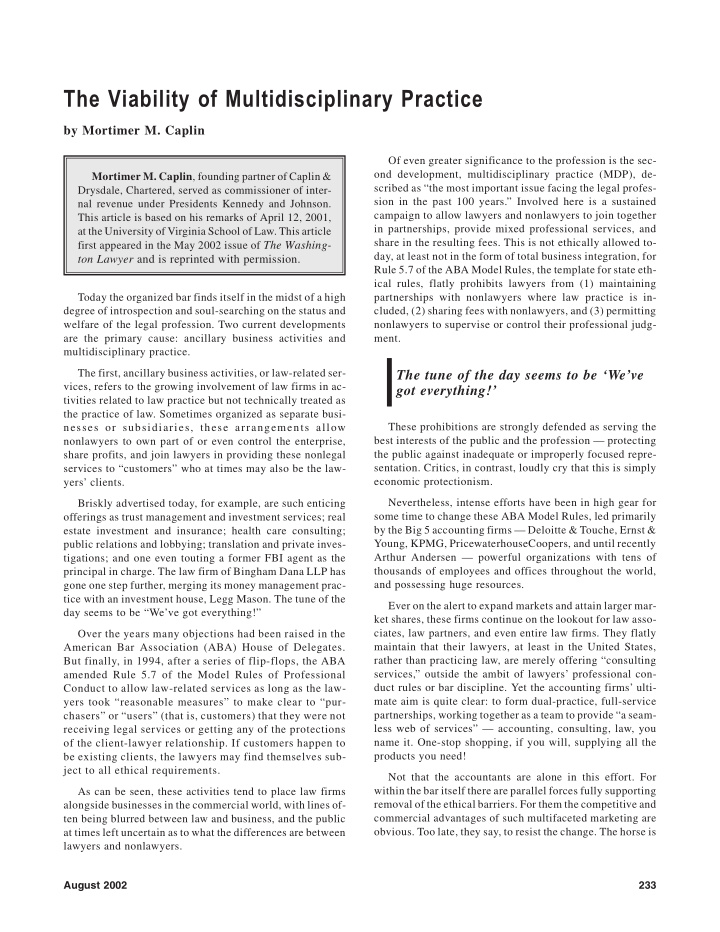



The Viability of Multidisciplinary Practice by Mortimer M. Caplin Of even greater significance to the profession is the sec- ond development, multidisciplinary practice (MDP), de- Mortimer M. Caplin , founding partner of Caplin & scribed as “the most important issue facing the legal profes- Drysdale, Chartered, served as commissioner of inter- sion in the past 100 years.” Involved here is a sustained nal revenue under Presidents Kennedy and Johnson. campaign to allow lawyers and nonlawyers to join together This article is based on his remarks of April 12, 2001, in partnerships, provide mixed professional services, and at the University of Virginia School of Law. This article share in the resulting fees. This is not ethically allowed to- first appeared in the May 2002 issue of The Washing- day, at least not in the form of total business integration, for ton Lawyer and is reprinted with permission. Rule 5.7 of the ABA Model Rules, the template for state eth- ical rules, flatly prohibits lawyers from (1) maintaining Today the organized bar finds itself in the midst of a high partnerships with nonlawyers where law practice is in- degree of introspection and soul-searching on the status and cluded, (2) sharing fees with nonlawyers, and (3) permitting welfare of the legal profession. Two current developments nonlawyers to supervise or control their professional judg- are the primary cause: ancillary business activities and ment. multidisciplinary practice. The first, ancillary business activities, or law-related ser- The tune of the day seems to be ‘We’ve vices, refers to the growing involvement of law firms in ac- got everything!’ tivities related to law practice but not technically treated as the practice of law. Sometimes organized as separate busi- nesses or subsidiaries, these arrangements allow These prohibitions are strongly defended as serving the best interests of the public and the profession — protecting nonlawyers to own part of or even control the enterprise, the public against inadequate or improperly focused repre- share profits, and join lawyers in providing these nonlegal services to “customers” who at times may also be the law- sentation. Critics, in contrast, loudly cry that this is simply economic protectionism. yers’ clients. Nevertheless, intense efforts have been in high gear for Briskly advertised today, for example, are such enticing offerings as trust management and investment services; real some time to change these ABA Model Rules, led primarily by the Big 5 accounting firms — Deloitte & Touche, Ernst & estate investment and insurance; health care consulting; Young, KPMG, PricewaterhouseCoopers, and until recently public relations and lobbying; translation and private inves- tigations; and one even touting a former FBI agent as the Arthur Andersen — powerful organizations with tens of thousands of employees and offices throughout the world, principal in charge. The law firm of Bingham Dana LLP has gone one step further, merging its money management prac- and possessing huge resources. tice with an investment house, Legg Mason. The tune of the Ever on the alert to expand markets and attain larger mar- day seems to be “We’ve got everything!” ket shares, these firms continue on the lookout for law asso- ciates, law partners, and even entire law firms. They flatly Over the years many objections had been raised in the American Bar Association (ABA) House of Delegates. maintain that their lawyers, at least in the United States, rather than practicing law, are merely offering “consulting But finally, in 1994, after a series of flip-flops, the ABA amended Rule 5.7 of the Model Rules of Professional services,” outside the ambit of lawyers’ professional con- duct rules or bar discipline. Yet the accounting firms’ ulti- Conduct to allow law-related services as long as the law- mate aim is quite clear: to form dual-practice, full-service yers took “reasonable measures” to make clear to “pur- chasers” or “users” (that is, customers) that they were not partnerships, working together as a team to provide “a seam- less web of services” — accounting, consulting, law, you receiving legal services or getting any of the protections of the client-lawyer relationship. If customers happen to name it. One-stop shopping, if you will, supplying all the products you need! be existing clients, the lawyers may find themselves sub- ject to all ethical requirements. Not that the accountants are alone in this effort. For within the bar itself there are parallel forces fully supporting As can be seen, these activities tend to place law firms alongside businesses in the commercial world, with lines of- removal of the ethical barriers. For them the competitive and commercial advantages of such multifaceted marketing are ten being blurred between law and business, and the public at times left uncertain as to what the differences are between obvious. Too late, they say, to resist the change. The horse is lawyers and nonlawyers. August 2002 233
Recommend
More recommend